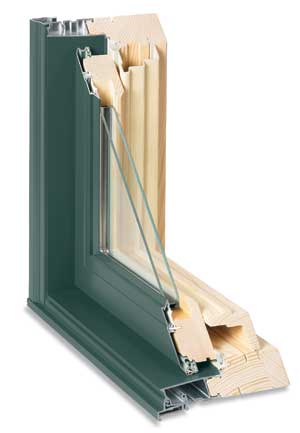Building Green with Windows and Doors
|
*Clad wood windows allow a traditional wood look on the interior while having the protection on the exterior against moisture and ultraviolet radiation. Window cladding materials include vinyl (PVC/plastic) (see characteristics of vinyl), rolled-form aluminum and extruded aluminum. Compared with rolled-form aluminum, extruded aluminum is thicker (the thickness of a quarter compared with the thickness of a pop-can), maintains its tensile strength and is 50 percent stronger.
Cladding finishes provide further protection. Specific performance requirements of paint finishes are based on location and project and include items such as salt fog, factory pollutants and temperature fluctuations. AAMA specifications apply to paint finishes on different cladding materials. AAMA 2605-02 is a new 10-year specification upgrade that requires Kynar (a 70 percent polyvinylidene fluoride resin) in the binder-resin on extruded aluminum substrate.
The combination of extruded aluminum cladding and AAMA 2605-02 finish provides superior protection from damage during installation and everyday exposure to the elements.
|
*Air infiltration (AL) flows two ways. Infiltration is outside air making its way into the building due to wind or a depressurized situation within the structure. Exfiltration is inside air making its way out of the building due to an over-pressurized building or from a negative wind load sucking air from the building. Heated air generally flows through cracks, around weatherstripping and poorly sealed frames.
Air infiltration is measured in cubic feet per minute per square foot of window or door. Lower numbers indicate less air infiltration.
*Design Pressure (DP) is the amount of pressure a window or door is designed to withstand when closed and locked. Each DP rating also establishes other performance factors such as structural pressure, water penetration and air infiltration.
As a frame of reference, a DP 40 rating means that a window or door is tested to 60 pounds per square foot (equal to a 155 m.p.h. [250 km/hr] wind) and must withstand water penetration under conditions equal to 8 inches (20 cm) of rain per hour driven by 50 mph (80 km/hr) winds.
The higher a DP number a window or door is rated at, the better the performance. DP ratings are established by independent testing laboratories. DP ratings are based on performance of new products, and do not speculate on durability and continued performance over time.
Clearly, as the demand for Green Building continues to grow, a knowledge of how windows and doors impact energy efficiency will become increasingly important. In addition, an understanding of the complex industry standards and criteria that apply to specifying windows and doors for Green Building will become critical as well.










